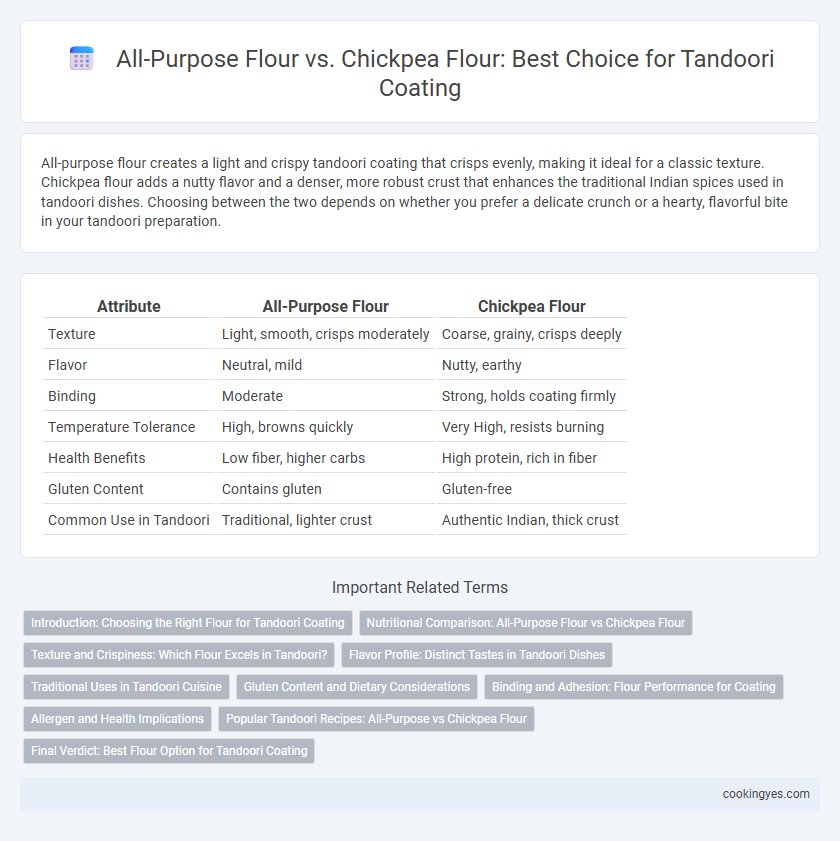All-purpose flour creates a light and crispy tandoori coating that crisps evenly, making it ideal for a classic texture. Chickpea flour adds a nutty flavor and a denser, more robust crust that enhances the traditional Indian spices used in tandoori dishes. Choosing between the two depends on whether you prefer a delicate crunch or a hearty, flavorful bite in your tandoori preparation.
Table of Comparison
| Attribute | All-Purpose Flour | Chickpea Flour |
|---|---|---|
| Texture | Light, smooth, crisps moderately | Coarse, grainy, crisps deeply |
| Flavor | Neutral, mild | Nutty, earthy |
| Binding | Moderate | Strong, holds coating firmly |
| Temperature Tolerance | High, browns quickly | Very High, resists burning |
| Health Benefits | Low fiber, higher carbs | High protein, rich in fiber |
| Gluten Content | Contains gluten | Gluten-free |
| Common Use in Tandoori | Traditional, lighter crust | Authentic Indian, thick crust |
Introduction: Choosing the Right Flour for Tandoori Coating
Choosing the right flour for tandoori coating significantly impacts texture and flavor. All-purpose flour creates a light, crispy crust, ideal for a traditional crunch, while chickpea flour adds a nutty flavor and denser, protein-rich coating that enhances authenticity. Understanding the distinct properties of these flours helps achieve the perfect balance in tandoori dishes.
Nutritional Comparison: All-Purpose Flour vs Chickpea Flour
Chickpea flour offers a higher protein content and greater dietary fiber than all-purpose flour, making it a more nutritious choice for Tandoori coating. It also provides essential minerals such as iron, magnesium, and folate, which are less abundant in all-purpose flour. While all-purpose flour contributes mainly carbohydrates, chickpea flour supports better satiety and glycemic control, enhancing the overall health profile of Tandoori dishes.
Texture and Crispiness: Which Flour Excels in Tandoori?
Chickpea flour enhances tandoori coating with a denser, crispier texture due to its higher protein content and nutty flavor profile, creating a more authentic and robust crust. All-purpose flour produces a lighter, softer coating but lacks the distinctive crunch and depth that chickpea flour provides in tandoori dishes. For a traditional, crisp tandoori texture, chickpea flour consistently excels over all-purpose flour.
Flavor Profile: Distinct Tastes in Tandoori Dishes
All-purpose flour offers a neutral taste that allows the spices in tandoori dishes to shine without altering the overall flavor profile. Chickpea flour, also known as besan, imparts a nutty, earthy flavor that enhances the traditional tandoori taste with added depth and complexity. The choice between all-purpose and chickpea flour significantly influences the aromatic and savory qualities, making each tandoori coating distinctly unique.
Traditional Uses in Tandoori Cuisine
Chickpea flour, also known as besan, is traditionally preferred in Tandoori cuisine for its nutty flavor and ability to create a crispy, golden coating that adheres well to marinated meats and vegetables. All-purpose flour is less common but sometimes used to lighten the batter or in combination with chickpea flour for a balanced texture. Chickpea flour's gluten-free nature and rich protein content align with authentic Tandoori recipes, enhancing both taste and nutritional value.
Gluten Content and Dietary Considerations
Chickpea flour is gluten-free, making it a suitable choice for gluten-sensitive individuals in tandoori coatings, while all-purpose flour contains gluten, providing a chewier texture and better binding. Chickpea flour adds a nutty flavor and is higher in protein and fiber, offering enhanced nutritional benefits compared to all-purpose flour. Selecting between these flours impacts both the dietary compatibility and the traditional crispness of the tandoori coating.
Binding and Adhesion: Flour Performance for Coating
Chickpea flour provides superior binding and adhesion for Tandoori coatings due to its high protein content and slightly coarse texture, which helps the marinade stick effectively to the meat. All-purpose flour, while creating a lighter coating, lacks the same adhesive properties, often resulting in a less cohesive crust. The choice of chickpea flour enhances the durability of the Tandoori coating, ensuring a flavorful and well-attached crust after cooking.
Allergen and Health Implications
All-purpose flour commonly contains gluten, making it unsuitable for individuals with celiac disease or gluten sensitivity, while chickpea flour is naturally gluten-free and a better alternative for those avoiding allergens. Chickpea flour is rich in protein, fiber, and essential vitamins, enhancing the nutritional profile of tandoori coatings compared to the more refined all-purpose flour. Using chickpea flour can reduce the risk of allergic reactions and provide a healthier, nutrient-dense option for a flavorful, traditional tandoori crust.
Popular Tandoori Recipes: All-Purpose vs Chickpea Flour
Popular tandoori recipes often use all-purpose flour to achieve a light, crispy coating that enhances the smoky flavor of marinated meats. Chickpea flour, rich in protein and gluten-free, offers a denser, earthier crust commonly preferred in vegan or gluten-sensitive tandoori dishes. The choice between all-purpose and chickpea flour significantly influences texture, taste, and dietary compatibility in authentic tandoori preparations.
Final Verdict: Best Flour Option for Tandoori Coating
Chickpea flour outperforms all-purpose flour for tandoori coating due to its ability to create a crispier, more flavorful crust that enhances traditional Indian spices. Its higher protein content and natural nuttiness contribute to better adhesion and a richer taste, critical for authentic tandoori dishes. All-purpose flour may offer a lighter coat but lacks the depth and texture that chickpea flour consistently delivers.
All-Purpose Flour vs Chickpea Flour for Tandoori Coating Infographic

 cookingyes.com
cookingyes.com